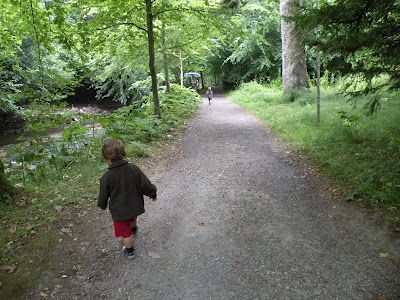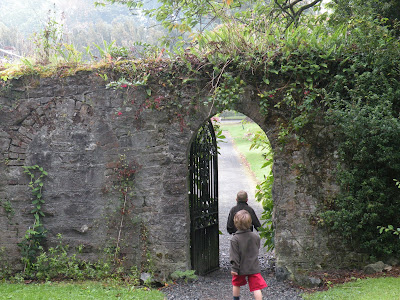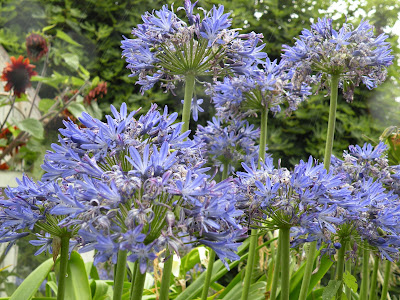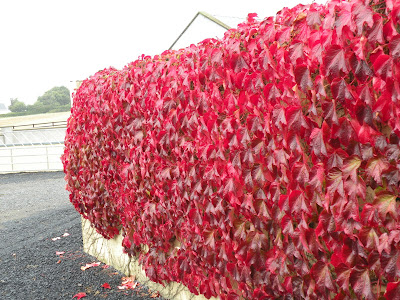The cradle of Irish civilization and the Celts' spiritual home, the Midlands encompass some of Ireland's most sacred and symbolic sites. Much of the region is ignored, but the ragged landscapes of lush pastures, lakes and bogland reveal ancient Celtic crosses, gracious Norman abbeys and Gothic Revival castles.
(From the tour book)
Birr Castle
 As we drove into the town of Birr, we were impressed by the walls around the Castle grounds. Birr Castle is still the private family home of the Parsons who have lived here as the Earls and Countesses of Rosse since 1620. The grounds are open to the public. First landscaped in the 18th century, many exotic trees and shrubs were brought here from foreign expeditions of the 6th Earl.
As we drove into the town of Birr, we were impressed by the walls around the Castle grounds. Birr Castle is still the private family home of the Parsons who have lived here as the Earls and Countesses of Rosse since 1620. The grounds are open to the public. First landscaped in the 18th century, many exotic trees and shrubs were brought here from foreign expeditions of the 6th Earl.I wanted to come for a nice walk.
 The Parsons are most noted for their contribution to astronomy - this telescope, built by the 3rd Earl in 1845, was the largest in the world for over 70 years, and through it, the Earl discovered the Whirlpool Nebula. The 56-ft wooden tube (seen here resting almost on the ground on the left side) is supported by two stone walls.
The Parsons are most noted for their contribution to astronomy - this telescope, built by the 3rd Earl in 1845, was the largest in the world for over 70 years, and through it, the Earl discovered the Whirlpool Nebula. The 56-ft wooden tube (seen here resting almost on the ground on the left side) is supported by two stone walls.
 This facade of the castle was made in the 1840's. It was originally a Norman castle dating from 1170. The star-shaped moat was built in 1847 to give work to Irish tennants during The Famine. There were plans to pump water from the river to fill it, but this was never done.
This facade of the castle was made in the 1840's. It was originally a Norman castle dating from 1170. The star-shaped moat was built in 1847 to give work to Irish tennants during The Famine. There were plans to pump water from the river to fill it, but this was never done. It took us about an hour to walk through the grounds. Since we were wet, I was very thankful that it was not cold!
It took us about an hour to walk through the grounds. Since we were wet, I was very thankful that it was not cold!


 We crossed six bridges on our walk. The boys shouted with excitement as we approached each and every one.
We crossed six bridges on our walk. The boys shouted with excitement as we approached each and every one. Aaron runs; Silas meanders.
Aaron runs; Silas meanders.
 Fall is here.
Fall is here. Double excitement - on a bridge spotting another bridge!
Double excitement - on a bridge spotting another bridge!
 Found some fish.
Found some fish.


 The Formal Garden
The Formal Garden

 Silas lags behind most of the time - we're going to lose him one of these days.
Silas lags behind most of the time - we're going to lose him one of these days.
 Aaron and the "ginormous" tree.
Aaron and the "ginormous" tree. These box hedges were planted by Sir William Parsons in the mid-1600's. They are 30 feet tall - according to the Guinness Book of Records, the tallest box hedges in the world.
These box hedges were planted by Sir William Parsons in the mid-1600's. They are 30 feet tall - according to the Guinness Book of Records, the tallest box hedges in the world.


 Aaron took this picture.
Aaron took this picture. So Silas wanted a turn too :)
So Silas wanted a turn too :) In the old stables there is an exhibit of the scientific achievements of those closely associated with Birr over the past two hundred years. We walked through this first gallery dedicated to the design, build, and discoveries of the Great Telescope. Other galleries show the work of Mary Countess of Rosse, a pioneer photographer in the 1840's, and of her son Sir Charles Parsons, the inventor of the Steam Turbine which played a significant role in the late 19th and early 20th century British Navy and continues to have immediate significance in the basic formula for all turbo jet air travel and similar power items in the production of electricity.
In the old stables there is an exhibit of the scientific achievements of those closely associated with Birr over the past two hundred years. We walked through this first gallery dedicated to the design, build, and discoveries of the Great Telescope. Other galleries show the work of Mary Countess of Rosse, a pioneer photographer in the 1840's, and of her son Sir Charles Parsons, the inventor of the Steam Turbine which played a significant role in the late 19th and early 20th century British Navy and continues to have immediate significance in the basic formula for all turbo jet air travel and similar power items in the production of electricity.(Info from the tour brochure)
 Aaron requested a picture next to "the silly guy". We certainly wouldn't ever want to forget that!
Aaron requested a picture next to "the silly guy". We certainly wouldn't ever want to forget that! For the engineers and architects reading this...a model of the Great Telescope...
For the engineers and architects reading this...a model of the Great Telescope... ...and an aerial view.
...and an aerial view.We drove further East while the sun made a brief appearance.
Our Scenic Drive through the Slieve Bloom Mountains




Back down from the clouds...
Rock of Dunamase
 The tourbook's description enticed me to make this one of our stops for Daniel's and the boys' sakes:
The tourbook's description enticed me to make this one of our stops for Daniel's and the boys' sakes:
 In many of the rest of the pictures, finding the boys is like doing a Where's Waldo book.
In many of the rest of the pictures, finding the boys is like doing a Where's Waldo book.
 What it once looked like.
What it once looked like.
 There's not much to say about these pictures other than it was really fun and surreal to be the only ones there exploring these ruins.
There's not much to say about these pictures other than it was really fun and surreal to be the only ones there exploring these ruins.











 This may be the only running Silas did all day - he ran 10 feet after I said, "Go! Beat Aaron."
This may be the only running Silas did all day - he ran 10 feet after I said, "Go! Beat Aaron."


















 The tourbook's description enticed me to make this one of our stops for Daniel's and the boys' sakes:
The tourbook's description enticed me to make this one of our stops for Daniel's and the boys' sakes:"The Rock of Dunamase, which looms dramatically above the plains, has long been a military site. Originally crowned by an Iron Age ring fort, the 13th-century castle which succeeded it is now more prominent - though it was virtually destroyed by Cromwellian forces in 1650. You can reach the battered keep by climbing up banks and ditches through two gateways and a fortified courtyard."
This sounded like the right occasion to wear white capris, right?
 In many of the rest of the pictures, finding the boys is like doing a Where's Waldo book.
In many of the rest of the pictures, finding the boys is like doing a Where's Waldo book. What it once looked like.
What it once looked like. There's not much to say about these pictures other than it was really fun and surreal to be the only ones there exploring these ruins.
There's not much to say about these pictures other than it was really fun and surreal to be the only ones there exploring these ruins.










 This may be the only running Silas did all day - he ran 10 feet after I said, "Go! Beat Aaron."
This may be the only running Silas did all day - he ran 10 feet after I said, "Go! Beat Aaron."

















We drove North.
Trim Castle

 Again, there's not much more I can explain about the castle. We just enjoyed exploring and imagining.
Again, there's not much more I can explain about the castle. We just enjoyed exploring and imagining.



 The boys' greatest excitement here was over this slug.
The boys' greatest excitement here was over this slug.









 Should have been keeping a better eye on Aaron...
Should have been keeping a better eye on Aaron...
 ..."But I was being careful" - as he's looking over the 25 ft wall.
..."But I was being careful" - as he's looking over the 25 ft wall.




 The Solar
The Solar





Hill of Tara
 The aerial views pictured on this plaque are necessary to grasping what the Hill of Tara is. Obviously, my pictures at ground level don't show much.(Click here to see more aerial views.)
The aerial views pictured on this plaque are necessary to grasping what the Hill of Tara is. Obviously, my pictures at ground level don't show much.(Click here to see more aerial views.)

 The Mound of the Hostages. The cremated remains of over two hundred people were found here - by far, the most found in any burial mound in Ireland.
The Mound of the Hostages. The cremated remains of over two hundred people were found here - by far, the most found in any burial mound in Ireland.
 The other two couples on the tour with us were from England and were very friendly. One of the men asked Daniel out-of-the-blue if he was Norwegian - said he looks like his wife's cousins. She is from Norway, and was interested in both our families' Norse roots.
The other two couples on the tour with us were from England and were very friendly. One of the men asked Daniel out-of-the-blue if he was Norwegian - said he looks like his wife's cousins. She is from Norway, and was interested in both our families' Norse roots.
 We walked up onto the highest point of the Hill where our tour guide told us of the significance of Tara throughout the history of Ireland up to modern times. It is said that the rebels of the 1798 uprising are buried in a mass grave beneath where we were standing, and 'The Liberator', Daniel O'Connell, held a huge assembly here in 1843 that attracted ~750,000 people.
We walked up onto the highest point of the Hill where our tour guide told us of the significance of Tara throughout the history of Ireland up to modern times. It is said that the rebels of the 1798 uprising are buried in a mass grave beneath where we were standing, and 'The Liberator', Daniel O'Connell, held a huge assembly here in 1843 that attracted ~750,000 people.
Trim Castle
In 1172, when Hugh de Lacy was granted the Liberty of Meath, he occupied this site bounded by the river Boyne to the north and marshy ground to the south.
By 1175, his original wooden fortification had been replaced with this unusual keep, later surrounded by curtain walls with a simple gate to the north and a bridge across the moat. The south curtain wall with its D-shaped towers was completed by 1200, when new siege tactics forced a change in the design of castles. Later the forebuildings and plinth were built, protecting the entrance and base of the keep.
As the town and approach roads were developed, the barbican gate provided a new entrance from the south. After the siege of 1224, the north curtain walls, towers and Trim gate required major repairs. During a period of prosperity in the second half of the 13th century, the great hall and solar were constructed on the site of the north curtain wall and tower. Trim and its abbeys, and the Cathedral and Borough of Newtown developed in the security of the castle.
The Boyne was used for transport of goods to the river gate. Stores, workshops and kitchens were built in the castle yard.
Though the castle buildings were often adapted to suit changing military and domestic needs, much of the fabric of Trim Castle has remained unchanged since the height of Anglo-Norman power in Ireland.

 Again, there's not much more I can explain about the castle. We just enjoyed exploring and imagining.
Again, there's not much more I can explain about the castle. We just enjoyed exploring and imagining.


 The boys' greatest excitement here was over this slug.
The boys' greatest excitement here was over this slug.








 Should have been keeping a better eye on Aaron...
Should have been keeping a better eye on Aaron... ..."But I was being careful" - as he's looking over the 25 ft wall.
..."But I was being careful" - as he's looking over the 25 ft wall.



 The Solar
The Solar




Hill of Tara
 The aerial views pictured on this plaque are necessary to grasping what the Hill of Tara is. Obviously, my pictures at ground level don't show much.
The aerial views pictured on this plaque are necessary to grasping what the Hill of Tara is. Obviously, my pictures at ground level don't show much.(Info from the plaque)
The royal site of Tara, an ancient ritual landscape, was a place of burial and assembly and was the premier religious centre of pagan Ireland.
The mythological Kings of Tara had divine attributes and were venerated in the ceremonies performed here. During the medieval period the title 'King of Tara' was identified with the High King of Ireland.
Saint Patrick's biographers claim that it was here that he had his most famous victory over the pagan druids, during the reign of the 5th century King Laoghaire.
There are over thirty visible monuments on the hill and research continues to reveal new sites. Most of these monuments relate to burial or ritual and form an unbroken sequence spanning some 4,000 years from about 3500 BC to the 6th or 7th Century AD. There are further sites in the surrounding countryside, confirming that Tara was the focal point of a wider complex of ritual and settlement sites.

 The Mound of the Hostages. The cremated remains of over two hundred people were found here - by far, the most found in any burial mound in Ireland.
The Mound of the Hostages. The cremated remains of over two hundred people were found here - by far, the most found in any burial mound in Ireland. The other two couples on the tour with us were from England and were very friendly. One of the men asked Daniel out-of-the-blue if he was Norwegian - said he looks like his wife's cousins. She is from Norway, and was interested in both our families' Norse roots.
The other two couples on the tour with us were from England and were very friendly. One of the men asked Daniel out-of-the-blue if he was Norwegian - said he looks like his wife's cousins. She is from Norway, and was interested in both our families' Norse roots. We walked up onto the highest point of the Hill where our tour guide told us of the significance of Tara throughout the history of Ireland up to modern times. It is said that the rebels of the 1798 uprising are buried in a mass grave beneath where we were standing, and 'The Liberator', Daniel O'Connell, held a huge assembly here in 1843 that attracted ~750,000 people.
We walked up onto the highest point of the Hill where our tour guide told us of the significance of Tara throughout the history of Ireland up to modern times. It is said that the rebels of the 1798 uprising are buried in a mass grave beneath where we were standing, and 'The Liberator', Daniel O'Connell, held a huge assembly here in 1843 that attracted ~750,000 people.This is the view to the North...
 ...to the East...
...to the East...
 ...to the South...
...to the South...
 ...and to the West.
...and to the West.
OK, so the amazing views were left to our imagination, but the visit was still worth while.
 ...to the East...
...to the East... ...to the South...
...to the South... ...and to the West.
...and to the West.OK, so the amazing views were left to our imagination, but the visit was still worth while.
Monasterboice
 Founded in the 5th century by St Buite, who was a student of St Patrick, this monastic settlement is one of the most famous religious sites in the country. Beyond a list of abbots (759-1122), little is known of the story of this monastery. There are no records of Viking raids, though the Vikings occupied the place for some time before they were driven out with great slaughter in 968. With the foundation of the great Cistercian abbey at Mellifont in 1142, Monasterboice fell into decay. The site was occuped by a parochial church in the 13th century. None of the original buildings have survived - the oldest monuments here are the three High Crosses and the round tower all dating from the 10th century. The crosses belong to the 'scriptural group', so called because of the Biblical scenes they depict. They are the greatest treasure of Monasterboice, some of the best examples of High Crosses in Ireland.
Founded in the 5th century by St Buite, who was a student of St Patrick, this monastic settlement is one of the most famous religious sites in the country. Beyond a list of abbots (759-1122), little is known of the story of this monastery. There are no records of Viking raids, though the Vikings occupied the place for some time before they were driven out with great slaughter in 968. With the foundation of the great Cistercian abbey at Mellifont in 1142, Monasterboice fell into decay. The site was occuped by a parochial church in the 13th century. None of the original buildings have survived - the oldest monuments here are the three High Crosses and the round tower all dating from the 10th century. The crosses belong to the 'scriptural group', so called because of the Biblical scenes they depict. They are the greatest treasure of Monasterboice, some of the best examples of High Crosses in Ireland.
(Info from tour book and plaque at the site)
 Muiredach's Cross is the finest of its kind in Ireland - the sculpting is still remarkably fresh after more than a thousand years.
Muiredach's Cross is the finest of its kind in Ireland - the sculpting is still remarkably fresh after more than a thousand years.
 The West face depicts the life of Christ.
The West face depicts the life of Christ.

 The East face, Old Testament stories.
The East face, Old Testament stories.
 The 21ft tall West Cross is one of the largest in Ireland.
The 21ft tall West Cross is one of the largest in Ireland.



 The North Cross shows the crucifixion..
The North Cross shows the crucifixion..
The graveyards of many of these old monasteries and abbeys are still used. While we were here, a man came in with his dog and stood for a few moments in front of one gravesite. When he left, I walked over to see who he had come to remember. My heart sank - she was a 12 yr old girl who died four years ago. I couldn't help but wonder if that was her dad or an uncle - someone who misses her dearly - and I cried to think of how often I get impatient and irritated with our kids, or just simply take them for granted. Life is precious. Thank God for it - honor Him with it. Tomorrow is not a guarantee.


 On our way home, we passed through the town of Kells.
On our way home, we passed through the town of Kells.
 It was here that the famous Book of Kells was brought and protected in the Middle Ages before being moved in 1654 to Dublin to protect it from Cromwell's army. We saw it at Trinity College while we were in Dublin.
It was here that the famous Book of Kells was brought and protected in the Middle Ages before being moved in 1654 to Dublin to protect it from Cromwell's army. We saw it at Trinity College while we were in Dublin.
 Founded in the 5th century by St Buite, who was a student of St Patrick, this monastic settlement is one of the most famous religious sites in the country. Beyond a list of abbots (759-1122), little is known of the story of this monastery. There are no records of Viking raids, though the Vikings occupied the place for some time before they were driven out with great slaughter in 968. With the foundation of the great Cistercian abbey at Mellifont in 1142, Monasterboice fell into decay. The site was occuped by a parochial church in the 13th century. None of the original buildings have survived - the oldest monuments here are the three High Crosses and the round tower all dating from the 10th century. The crosses belong to the 'scriptural group', so called because of the Biblical scenes they depict. They are the greatest treasure of Monasterboice, some of the best examples of High Crosses in Ireland.
Founded in the 5th century by St Buite, who was a student of St Patrick, this monastic settlement is one of the most famous religious sites in the country. Beyond a list of abbots (759-1122), little is known of the story of this monastery. There are no records of Viking raids, though the Vikings occupied the place for some time before they were driven out with great slaughter in 968. With the foundation of the great Cistercian abbey at Mellifont in 1142, Monasterboice fell into decay. The site was occuped by a parochial church in the 13th century. None of the original buildings have survived - the oldest monuments here are the three High Crosses and the round tower all dating from the 10th century. The crosses belong to the 'scriptural group', so called because of the Biblical scenes they depict. They are the greatest treasure of Monasterboice, some of the best examples of High Crosses in Ireland.(Info from tour book and plaque at the site)
 Muiredach's Cross is the finest of its kind in Ireland - the sculpting is still remarkably fresh after more than a thousand years.
Muiredach's Cross is the finest of its kind in Ireland - the sculpting is still remarkably fresh after more than a thousand years. The West face depicts the life of Christ.
The West face depicts the life of Christ.
 The East face, Old Testament stories.
The East face, Old Testament stories. The 21ft tall West Cross is one of the largest in Ireland.
The 21ft tall West Cross is one of the largest in Ireland.


 The North Cross shows the crucifixion..
The North Cross shows the crucifixion..The graveyards of many of these old monasteries and abbeys are still used. While we were here, a man came in with his dog and stood for a few moments in front of one gravesite. When he left, I walked over to see who he had come to remember. My heart sank - she was a 12 yr old girl who died four years ago. I couldn't help but wonder if that was her dad or an uncle - someone who misses her dearly - and I cried to think of how often I get impatient and irritated with our kids, or just simply take them for granted. Life is precious. Thank God for it - honor Him with it. Tomorrow is not a guarantee.


 On our way home, we passed through the town of Kells.
On our way home, we passed through the town of Kells. It was here that the famous Book of Kells was brought and protected in the Middle Ages before being moved in 1654 to Dublin to protect it from Cromwell's army. We saw it at Trinity College while we were in Dublin.
It was here that the famous Book of Kells was brought and protected in the Middle Ages before being moved in 1654 to Dublin to protect it from Cromwell's army. We saw it at Trinity College while we were in Dublin.That was a full day!
















Hey Sarah, Your days sound like so much fun! I wish we could join you. I miss you and hope we can connect soon!
ReplyDelete